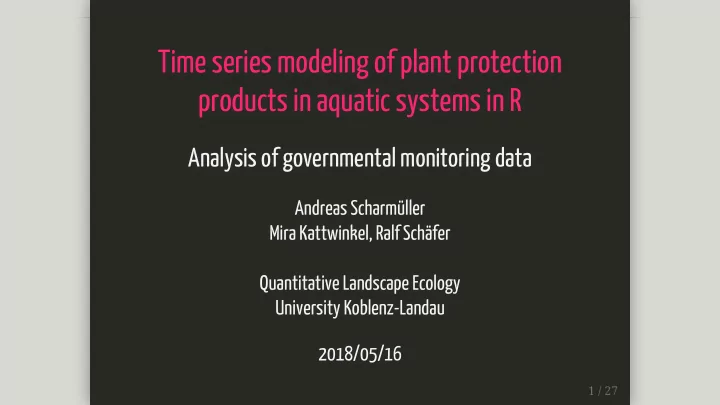

Time series modeling of plant protection products in aquatic systems in R Analysis of governmental monitoring data Andreas Scharmüller Mira Kattwinkel, Ralf Schäfer Quantitative Landscape Ecology University Koblenz-Landau 2018/05/16
Quantitative Landscape Ecology R and other open source software Ecotoxicology Effects of Plant Protection Products (PPP) / pesticides on the environment Aquatic systems
Introduction Why study pesticides? Highly used in modern agriculture, gardens Environmental concern Glyphosate, Neonicotinoids, ... Germany (2016): 753 pesticides 270 substances Groups: fungicides herbicides insecticides
Data
Data
Data federal monitoring program period: 2005-2015 3116 sampling sites 3.246.690 susbtance detections 495 substances stored in a PostgreSQL data base:
Data require (RPostgreSQL) require (data.table) # load data drv = dbDriver("PostgreSQL") con = dbConnect( ... ) q = "SELECT * FROM schema.tab" dt = dbGetQuery(con, query = q) setDT(dt) dbDisconnect(con) dbUnloadDriver(drv)
Data
Data Left skewed environmental data LOQ: Limit of quantification Excess of 0s Heterogenous data set Sampling frequency LOQ can change over time Measured compounds Seasonal variability
Comparability between substances? 10µg of substance A as toxic as 10µg od substance B?
Comparability between substances? 10µg of substance A as toxic as 10µg od substance B? It is only the dose which makes a thing poison. — Paracelsus
Comparability between substances? 10µg of substance A as toxic as 10µg od substance B? It is only the dose which makes a thing poison. — Paracelsus Ecotoxicological tests Effect Concentrations - EC50
Comparability between substances? 10µg of substance A as toxic as 10µg od substance B? It is only the dose which makes a thing poison. — Paracelsus Ecotoxicological tests Effect Concentrations - EC50 EPA ECOTOX data base
Toxic Unit (TU) in-stram concentrations ... dt$value[1:3] # concentrations in µg/L ## [1] 0.120 0.018 0.000 ... realte to effects concentration TU algae = log 10 ( ) EC 50 algae
Research questions
Research questions Are there months of increased in-stream occurrence of pesticides? Occurrence model: Binary data: concentration > LOQ: 1, concentration < LOQ: 0 pa ~ month + year + site How are different organism groups (Algae, Invertebrates, Fish) effected by pesticide concentrations throughout the year? Effect/TU-Model: Continuous data TU ~ month + site
Data preparation
Filter data dt = dt[state == 'SN'] dt = dt[pest_type % in % c('fungicide', 'herbicide', 'insecticide')]
Filter data dt = dt[state == 'SN'] dt = dt[pest_type % in % c('fungicide', 'herbicide', 'insecticide')] uniqueN(dt$site) ## [1] 413 dt[ i = value > 0, j = .N, by = pest_type] ## pest_type N ## 1: fungicide 2455 ## 2: herbicide 10890 ## 3: insecticide 875
Filter data Substances quantification-ratio > 5% subst_fin = dt[ , .(perc = .SD[ value > 0, .N ] / .N), subst_name ][perc > 0.05][order(-perc)] subst_fin[ , perc := round(perc,2)] head(subst_fin) ## subst_name perc ## 1: Boscalid 0.39 ## 2: Bentazon 0.38 ## 3: Isoproturon 0.37 ## 4: Quinmerac 0.36 ## 5: Glyphosate 0.29 ## 6: Azoxystrobin 0.27 nrow(subst_fin) ## [1] 31
Occurrence model
Occurrence model fit the model for each substancre individually mdt[ , pa := as.numeric(as.logical(value)) ] mdt[ , time := as.numeric(date) / 1000 ] require (mgcv) for (i in seq_along(substances)) { # for 31 pesticides # ... mdt = dt[ subst == substances[i] ] mod_pa = gam(pa ~ s(month, bs = 'cc', k = 12) + s(time, k = 20) + s(year, bs = 're') + s(site, bs = 're'), data = mdt, family = binomial(link = 'logit'), method = 'REML') # ... }
Occurrence model - Herbicides
Occurrence model - Herbicides
Occurrence model - Herbicides
Occurrence model - Fungicides
Effect model
Effect model Effect model dt[ , TU_algae := log10(value / EC50_algae) ] dt[ , TU_inv := log10(value / EC50_inv) ] dt[ , TU_fish := log10(value / EC50_fish) ] Maximum per site & month dt_agg = dt[ , .(maxTU_al = max(TU_algae), maxTU_iv = max(TU_inv), maxTU_fi = max(TU_fish)), .(site, month) ]
Effect model maximum: TU-Algae, TU-Invertebrates, TU-Fish require (mgcv) for (i in seq_along(todo)) { # for 3 TUs # ... mod_al = gam(maxTU_al ~ s(month, bs = 'cc', k = 12) + s(site, bs = 're'), family = gaussian(), data = mdt_agg, method = 'REML') # ... }
Effect model All organism groups (Algae, Fish, Invertebrates)
Conclusions Occurrence model identify peaks in occurence (for well measured substances) Effect model underestimation of effects sampling effort different physical chemical properties of susbstances Improve model include interactions refine selection of EC50 vlaues for TU calculations other covariates: percentage of agriculture in catchments precipitation on/before sampling date
R packages + tools data storage + preparation require (RPostgreSQL) require (data.table) modeling require (mgcv) visualization require (ggplot2) require (sf) slides require (rmarkdown) require (knitr) require (xaringan)
Time series modeling of plant protection products in aquatic systems in R Analysis of governmental monitoring data Thank you for your attention! Andreas Scharmüller Mira Kattwinkel, Ralf Schäfer Quantitative Landscape Ecology University Koblenz-Landau @andschar scharmueller@uni-landau.de
Recommend
More recommend